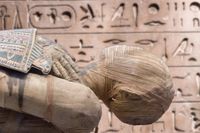In an enthralling chapter from the annals of Egyptology, the Bashiri Mummy, also known as the Mummy of Pacheri, continues to captivate scholars and enthusiasts alike since its controversial discovery by famed archaeologist Howard Carter in 1919. Unearthed in the mystical realm of Luxor, within the Valley of the Kings, this mummy stands apart not only because of its intricate wrappings, akin to those of its well-known counterpart, King Tutankhamun, but also due to the mystery shrouding its identity and preservation methods.
The Bashiri Mummy has been dubbed the “untouchable one,” a moniker that reflects researchers' reluctance to unravel its layers for further study, potentially risking damage to this ancient artifact. Interestingly, while many ancient mummies have succumbed to the unyielding hands of time and even careless handling—often leading to their destruction—this particular mummy remains largely untouched thanks to modern technology.
Classified as dating back to the Ptolemaic Era, specifically between 305 B.C.E. and 30 B.C.E., the Bashiri Mummy stands approximately 2,300 years old. Recent advances in imaging techniques, such as X-rays and CT scans, have revolutionized the way researchers approach mummies without committing to the destructive unwrapping that was once commonplace in archaeological practices. Previously, scholars believed unwrapping was the sole pathway to understanding, but this method frequently resulted in irreparable damage. As noted by the American Museum of Natural History, “In the past, the only way to learn about a mummy was to unwrap it. But this widespread practice destroyed the mummy, often detaching body parts.”
Today’s scientists and Egyptologists opt for non-invasive methodologies that uphold the dignity of the deceased. For the Bashiri Mummy, initial scans revealed that it belonged to an adult male measuring around 5.5 feet tall. The analysis also discovered a name inscribed, though the precise reading remains a matter of debate among experts; the names Pacheri and Nenu both emerge as plausible candidates for identification.
As researchers pushed beyond the initial findings, they uncovered more about the mummy’s ornate encasement. The Egypt Museum detailed that the mummy was draped in a decoratively designed wrappings depicting various funerary themes. Iconography featured prominently, with scenes depicting the deceased reclined on a bed, accompanied by goddess representations such as Isis and Nephtys, alongside the four sons of Horus. The feet encasement was particularly notable for its images of Anubis, the revered funerary god of ancient Egypt.
The meticulous care evident in this mummy's embalming hints at a personage of significance—perhaps someone of considerable status or affluence within society. It is this combination of mystery and reverence that propels the Bashiri Mummy into the collective consciousness of modern Egyptology. Although scholars are cautious in their approach, there is a palpable excitement for what future innovations in imaging technology might unveil about this enigma.
Various studies corroborate the benefits of such technology in advancing our understanding of ancient Egyptian mummies. Recent research discussed in Frontiers highlights the revelations gleaned from CT scans of other mummies, such as the Mummy of King Amenhotep I. Even more remarkable are findings from a 2024 study in Frontiers in Medicine, which details the investigation of a 3,500-year-old mummified woman, known as the “screaming woman,” showcasing how non-intrusive methodologies have transformed the field.
Looking into history’s darker days, it's crucial to acknowledge the bizarre craze in Europe from the 12th to the 19th centuries, where mummies had their remains ground up and consumed for supposed medicinal benefits. A poignant reminder of that era remains the Victorian practice of hosting “unwrapping parties,” a grotesque social event that relied on the destruction of mummies for entertainment. Yet, standing in stark contrast is today’s ethic of preservation and respect for ancient cultures, illustrating a valuable lesson learned through time.
As researchers and technologists look ahead, there is hope that they may soon develop even more sophisticated means to extract information about mummies like the Bashiri Mummy while honoring their past. The ongoing saga of the Mummy of Pacheri serves as both a mystery and a testament to the intersection of history and modern science, reflecting how far we’ve come in the quest to understand and preserve the stories of ancient civilizations.




